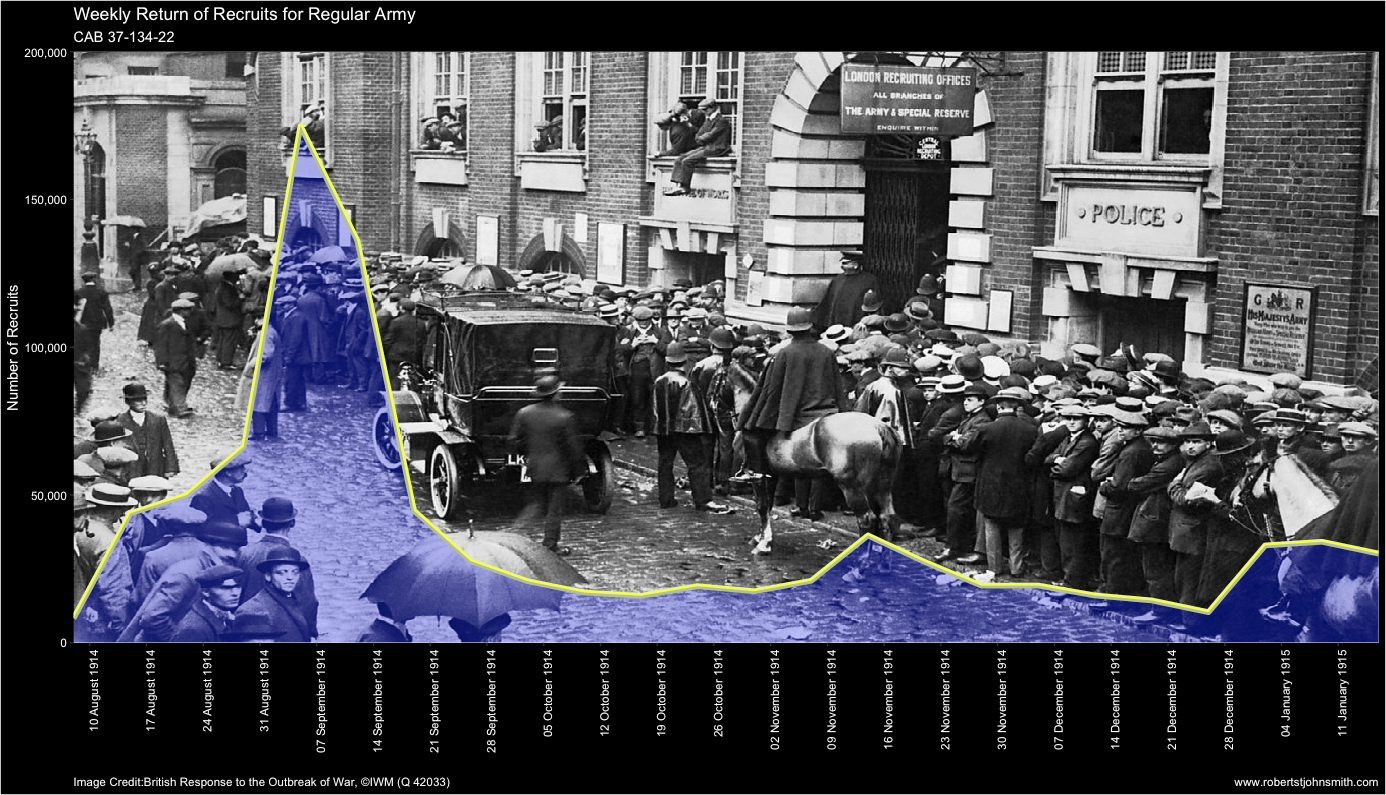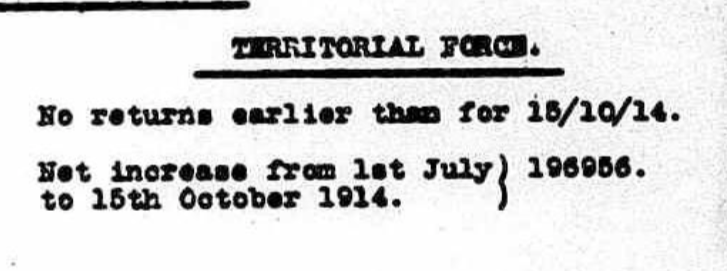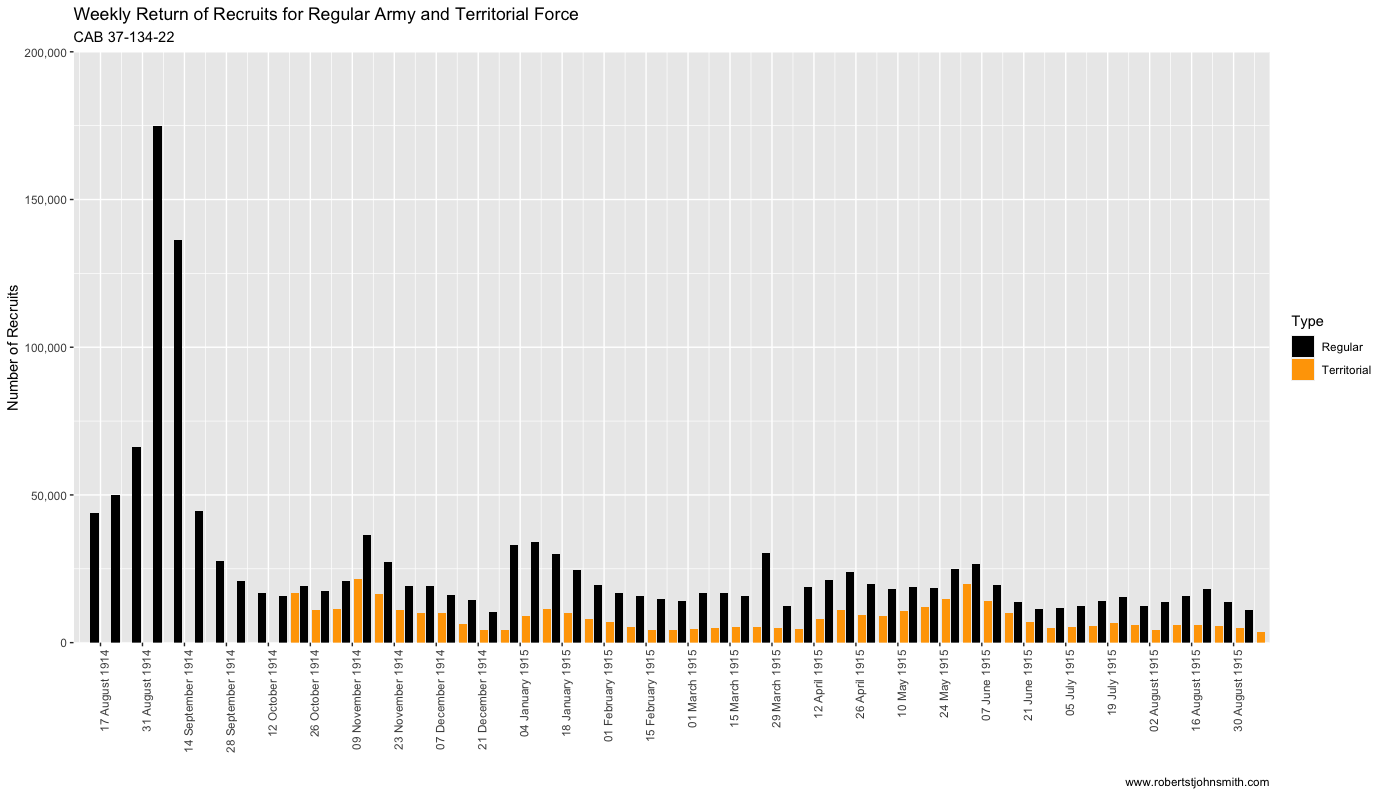Weekly Return of Recruits for Regular Army and the Territorial Force From 4th August,1914.
I am currently teaching myself R and R Studio and, as someone who has spent many an hour typing up tables from old documents, I am planning to put my datasets into a GitHub repository along with the code for anyone who might find them useful. I am not quite at that stage yet but wanted to post this example as it came up in a discussion with my fellow students on my MA course. From this discussion, I was pleased to find out that I am not the only one to find this chart questionable as evidence.
Creating the chart
I will come back and fill in this section once the GitHub repository is up and running but I wanted to work out how to create a 'tabloid type' chart with R. This was achieved by using the libraries ggplot2, magick and ggpubr.
The Chart

The graph normally appears with a narrative along the following lines.
Between 1914 and 1918, 4,970,902 enlisted in the army. Of these, 1,186,357 (25%) volunteered between August and December of 1914. In the week following the declaration of war, only 8,903 came forward, ramping up to 43,764 the week after. The highest numbers of enlistments (462,901) were recorded in the month of September and the 3rd of the month recorded the highest number of returns (33,204) for a single day after an article by Arthur Moore appeared in The Times on 30th August 1914 which provided the following depressing account of the British Expeditionary Force in retreat.1
Our losses are very great. I have seen the broken bits of many regiments . . . To sum up, the first great German effort has succeeded. We have to face the fact that the BEF, which bore the great weight of the blow, has suffered terrible losses and requires immediate and immense reinforcement.2
There is plenty of evidence, both contemporary and secondary, about the fact the Arthur Moore story led to an uptick on recruitment. While that narrative is not in question here,3 the validity of the numbers is and, in some examples, the use of these numbers to support other claims — such as how only 8,193 came forward in the first week, and regarding the rise in numbers in January 1915 being down to those who waited to join after Christmas. The reason for questioning the evidence is that the impression the chart gives, along with such commentary, is that the source behind them is comprehensive. However, a dig into the footnotes shows that whilst the graph derives from one source, several other sources were used to expand the narrative. If the weighting for all sources was the same, then this is would not be a problem, however source choice seems to be more selective.
The Big Numbers
The numbers 4,970,902 and 1,186,357 come from Statistics of the Military Effort of the British Empire during the Great War 1914-1920, written in 1922, and includes both the Territorial Force and Regular Army numbers.4 There is a weekly breakdown in the statistics for Territorial, but the Regular numbers are only listed by month.5 It is possible to be confident about the validity of the numbers listed here based on the following. A separate study, undertaken by the Board of Trade in 1919, titled Report of the State of Employment in the United Kingdom in April 1919, as compared with July 1914, and November 1918, uses an entirely different methodology but arrives at similar figures (4,896,000 vs 4,970,902) and there is a short, but useful passage about the differences in the History of the Ministry of Munitions Volume VI. Manpower and Dilution,1917-18.6 The numbers also appear to have been data cleansed, for example, removing absentees, doubtful entries, and duplicate enlistments. How much data was removed in the cleansing is hard to ascertain but in the appendix of a 1918 report on manpower, a figure of 126,000 is given as the total number of duplicate and transitional enlistments.7 In Peter Simkins Kitchener's Army: The Raising of the New Armies 1914-16 there is a good explanation for how these duplications came about. Some of it was down to confusion over the process — understandable given its novelty; there were also cases of men joining more than one unit — including reasons such as impatience or wanting to join friends in another unit; and, finally, there were a number of 'absconded recruits' who would secure the first day's pay and uniform, if it was available, and then disappear — sometimes repeating this process several times over.8 I have been unable to find out any more about duplicate entries, but I believe it is fair to assume these would likely have happened more in the earlier stages rather than later once the process had bedded in.
Statistics of the Military Effort includes a couple of interesting things of note in the commentary marked in bold below:
There are no figures available to show the strength of the Territorial Force on the 4th August, 1914, or the exact number of recruits who enlisted into the Territorial Force between that date and the 15th October,1914 . The strength in non-commissioned officers and men on 1st July 1914, may be taken as practically the strength at the outbreak of war, seeing that the intervening period of the year was one in which, usually, in peace time there were relatively few recruits and few casualties. The figures for the period 1st July to 15th October shown below represents merely the net increase for that period and are considerably below the number of recruits for that period, owing to the number of Territorial Force soldiers who had been weeded out on embodiment for medical reasons, &c, and who had for various reasons been required by, and transferred to, the Regular Army.9
The net increased number is given as 213,559.
In summary, the recruitment numbers overall are broadly correct (see below). The data has been cleansed to address issues, such as duplicate enlistments, and Territorial numbers are likely to be underestimated, with no exact figures available until 15th October 1914.
The Weekly Numbers
Returning to our chart, the first thing to note is that the number shown there represents the Regular Army only, ignoring the Territorial figures, which means that up until 15th October 1914, 23% of the data is missing.10 The source of the figures is a Cabinet Office report titled Weekly return of recruits for Regular Army and the Territorial Force, from August 4 1914, dated 15th September 1915.11 The report is split into two columns, one for Regular, the other for Territorial, and there is, at the top, a flag stating the same warning as in Statistics of the Military Effort, albeit using a slightly lower number.

Here is the unedited chart of the source.

To add further complications, the Regular returns run Sunday to Saturday and the Territorials run Wednesday to Tuesday. Comparing monthly totals from this source to the Military Statistics there is an absolute month on month difference between the two of around 10%. Notably, this is inflated by a large discrepancy between the figures for December 1914 (20% lower) and January 1915 (15% higher) and this relates in part to the discussion above. How much of those peaks and troughs are down to 'Friday afternoon admin' or 'clearing down the backlog'? This happened on at least one occasion in Scotland on 22nd August 1914 when regimental depots closed for three days to clear their paperwork.12 This is speculation, but clearing the backlog also fits the patterns of the weekly report being higher in January and then later, when time was a luxury, someone actually looking at them and realising they should have be done in December — rather than the rise in January being solely down to those who waited to join the army after Christmas; that is not to say there weren't those who waited, but I think this idea has been exaggerated. Also of note, (ignoring the odd week running's) is that the Territorial and Regular figures broadly follow the same pattern except for a peak in the third week of March and from July the relationship between the two tails off. Why this may be so is a conversation for another day — the main point I want to get across here is that the weekly numbers were different from the monthly reports, and the Territorial figures are missing for the first part, which means when a weekly figure is reported, such as how 8,193 volunteered in the first week, that number relates to the Regular Army only. This was the other main part of the discussion above as, given society at the time was more 'localised' and the Territorial Force Associations took a prominent place within the community, it would make more sense that those inclined to volunteer for the war would go there first.
In addition to the fact that war was declared on the 5th and Kitchener did not make his call to arms until the 7th, other considerations about that first week include how of the reported 8,193 a fair proportion occurred in London (a third of all recruits on the 8th August, and 1,200 alone on the 9th). As Peter Simkins notes, it can be argued that this does not provide a true reflection of the national response as many men turned up regionally only to face long and fruitless waits — this was after all an army that was only used to recruiting 30,000 annually.13 In Cardiff, for example, men who made the long trip to join the Welsh Regiment were faced with an army more concerned with the task of mobilisation than taking on new recruits, leading to some volunteers being sent away to join units in England.14 Returning to the subject of admin, attestation forms were also in short supply, causing one determined Territorial officer to rope in the presses of the Birmingham Post.15 Which again encourages speculation about how much recruitment work was done and then paperwork completed at a later date when time and resources allowed, especially considering the majority of this was done by hand.16
The Daily Numbers
Returning to the example narrative, where daily figures are quoted, they are from one of two sources: either Daily recruiting returns submitted to the Adjutant-General or Statistical tables showing number of recruits raised daily.17 The Adjutant-General report I have seen referred in some footnotes to an alternative title of 'Approximate number of recruits raised day by day from 3rd August 1914'.18 In the latter source, I believe the numbers have been adjusted and may have fed into Statistics of the Military Effort, based on these reports being produced by the Ministry of National Service who took over recruitment from the Adjutant-General in 1917.19 Neither of these reports are available digitally, but again it appears they are sources with different weightings.
A Problem?
In September 1940, a German bombing raid hit the War Office repository in Arnside Street, London, destroying two thirds of the service records of men who served in the First World War. This means there is no definitive source to check the figures against. In terms of the data that does exist, a very good point made in a 2019 article by Patrick Watt is that sources were 'not kept with future statistical analysis in mind' and were instead functional documents.20 Returning to the weekly report, which was produced by the Cabinet Office in September a week before the Battle of Loos and the first mass use of Kitchener's New Armies, it was probably accurate enough for its audience at the time, compared to the more forensic approached needed and undertaken by the Ministry of National Service in the later years of the war when manpower became scarce.
Returning to the example narrative, in some cases there is definitely some 'footnote inception' going on where rather than referring to the original source documents, they refer to another historian who has used these numbers and, in some rare instances, that historian refers to another historian, and so on. The inception seems to always end up back at Peter Simkins' Kitchener's Army or Becket and Simpsons' A Nation in Arms.21 While both books are seminal for many reasons, and they both make use of monthly, weekly and daily figures, a key difference between them and the account in question is, there are pages and pages of narrative around the figures - rather than rolling them together, drawing conclusions which ,especially knowing the data isn't robust, comes across at best spurious. Does trying to focus in on individual days and weeks add or detract from the headline that between August and December of 1914, over one million men volunteered?
Then there is the matter of the missing Territorial figures, which raises the question of whether their inclusion would change the narrative. The answer appears to be... no. An in-depth analysis of recruitment in Scotland undertaken in 2001, which included the Territorial Force, confirms the overall pattern.22 A paper that looked at the Worcestershire regiment published in 2014 also confirmed the same pattern.23 Referring to the aforementioned article by Patrick Watt, he observes that the numbers are 'broadly right'. So was this worth putting two and a half thousand words to paper for? I would argue yes. What research such as that undertaken by Young and others show is that there are numerous nuances where the narrative doesn't fit. For example, differences between urban and rural areas, uptake of volunteers in different industries, and local social and economic considerations all affected volunteering patterns.24 This shows that the overall narrative is not a one size-fits all answer. Both Adrian Gregory's (2008) The Last Great War: British Society in the Last Great War and Catriona Pennell's (2012) A Kingdom United: Popular responses to the Outbreak of the First World War in Britain and Ireland go to great lengths to show how complicated and varied responses to the outbreak of war were. Why then is there the presumption that answers can be found in a graph where the data is, for the want of a better word, dodgy?25
On a final note, while I can't imagine a file-and-folders history on the First World War being a (best) seller, compared to the drum-and-trumpet school of military history, it does make me wonder how much is missed when the administrative and logistical story of the War is overlooked.
-
Highly paraphrased from several sources. Sources of numbers listed throughout. ↩︎
-
The Times, 30 August 1914. ↩︎
-
E. Wallace, Kitchener's Army and the Territorial Forces (London: George Newnes, 1915), p.18. ↩︎
-
War Office, Statistics of the Military Effort of the British Empire during the Great War 1914--20 (London: HMSO, 1922), p.363. ↩︎
-
War Office, Statistics of the Military Effort, p.364. ↩︎
-
History of the Ministry of Munitions Volume VI. Manpower and Dilution,1917-18 (London: HMSO, 1921), pp.5-9. ↩︎
-
CAB/24/54/GT.4872, Man-Power Situation 1917-1918. Memo by Minister of National Service 17.7.18, Appendix VII. Mobilized Fighting Strength. England, Scotland and Wales 4th August 1914-30th, April 1918. ↩︎
-
P. Simkins, Kitchener's Army: The Raising of the New Armies 1914-1916 (Barnsley: Pen and Sword 2007 [1988]), pp.184-185. ↩︎
-
War Office, Statistics of the Military Effort, p.365. ↩︎
-
The total of regular returns up until the 15th according to that report was 698,933. Adding in the missing territorial figures makes a total of 912,492. 213,559 divided by 912,492 = 23%. See data below. ↩︎
-
CAB/37/134/22, Weekly return of recruits for Regular Army and the Territorial Force, from August 4, 1914,15 September 1915. ↩︎
-
Derek R. Young, 'Voluntary Recruitment in Scotland,1914-1916' (PhD, University of Glasgow, 2001), p.387. ↩︎
-
Simkins, Kitchener's Army, pp.51-52. ↩︎
-
Peter Robinson, 'A Welsh Response to the Great War: The 38th (Welsh) Division on the Western Front 1914-1919', (Ph D, Cardiff University, 2017), p.20. ↩︎
-
Simkins, Kitchener's Army, p.53. ↩︎
-
Whilst typewriters were in high demand, it appears the British Army were slow in fulfilling requests due to the high costs involved. By the end of the war, only approximately 5,000 were in use. Source: B. Hall, 'The British Army, information management and the First World War revolution in military affairs', Journal of Strategic Studies, 41(7) (2018), p.1015. ↩︎
-
W0 162/3, Daily recruiting returns submitted to the Adjutant-General, date unknown; NATS 1/398 Statistical tables showing number of recruits raised daily 1914-1917,1917. ↩︎
-
Alison Hine, 'The Provision and Management of Casualty Replacements for British Infantry Units on the Western Front during the First World War', (PhD, University of Birmingham, 2015), p.29 - footnote 46. ↩︎
-
CAB 24/54/GT.4872,'The Man-Power Situation, 1917-1918' & 'Appendix 1. The functions and constitution of the Ministry of National Service, 16 June 1918. ↩︎
-
P. Watt, 'Manpower, Myth and Memory: Analysing Scotland's Military Contribution to the Great War', Journal of Scottish Historical Society, 39(1) (2019), pp.75-100. ↩︎
-
Beckett & Simpson(ed.), A Nation in Arms (Pen and Sword Publishing, 2014). ↩︎
-
Young,'Voluntary Recruitment in Scotland,1914-1916'. ↩︎
-
N. Beeching, 'The Provincial Press & the Outbreak of War. A Unionist View in Worcestershire', Midland History, 39(2) (2014). ↩︎
-
Young, 'Voluntary Recruitment in Scotland,1914-1916', pp.380-393. ↩︎
-
A. Gregory, The Last Great War: British Society in the Last Great War (Cambridge University Press, 2008); C. Pennell, A Kingdom United: Popular responses to the Outbreak of the First World War in Britain and Ireland (Oxford Press, 2012). ↩︎